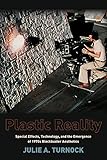Plastic Reality : Special Effects, Technology, and the Emergence of 1970s Blockbuster Aesthetics / Julie Turnock.
Material type: TextSeries: Film and Culture SeriesPublisher: New York, NY : Columbia University Press, [2015]Copyright date: ©2015Description: 1 online resource (384 p.) : 48 photos and diagramsContent type:
TextSeries: Film and Culture SeriesPublisher: New York, NY : Columbia University Press, [2015]Copyright date: ©2015Description: 1 online resource (384 p.) : 48 photos and diagramsContent type: - 9780231163521
- 9780231535274
- 791.43/75 23
- PN1995.9.B598 T87 2014
- online - DeGruyter
- Issued also in print.
| Item type | Current library | Call number | URL | Status | Notes | Barcode | |
|---|---|---|---|---|---|---|---|
 eBook
eBook
|
Biblioteca "Angelicum" Pont. Univ. S.Tommaso d'Aquino Nuvola online | online - DeGruyter (Browse shelf(Opens below)) | Online access | Not for loan (Accesso limitato) | Accesso per gli utenti autorizzati / Access for authorized users | (dgr)9780231535274 |
Browsing Biblioteca "Angelicum" Pont. Univ. S.Tommaso d'Aquino shelves, Shelving location: Nuvola online Close shelf browser (Hides shelf browser)

|

|

|

|

|

|

|
||
| online - DeGruyter The Nature of Value : How to Invest in the Adaptive Economy / | online - DeGruyter Business Secrets of the Trappist Monks : One CEO's Quest for Meaning and Authenticity / | online - DeGruyter The Robin Hood Rules for Smart Giving / | online - DeGruyter Plastic Reality : Special Effects, Technology, and the Emergence of 1970s Blockbuster Aesthetics / | online - DeGruyter The Metamorphoses of Fat : A History of Obesity / | online - DeGruyter The Winter Sun Shines In : A Life of Masaoka Shiki / | online - DeGruyter Robert N. Butler, MD : Visionary of Healthy Aging / |
Frontmatter -- Contents -- List of Illustrations -- Acknowledgments -- Introduction -- PART I. Before 1977 -- 1. Optical Animation -- 2. Before Industrial Light and Magic -- PART II. Circa 1977 -- 3. The Expanded Blockbuster -- 4. "The Buck Stops at Opticals" -- 5. A More Plastic Reality -- 6. "More Philosophical Grey Matter" -- PART III. The 1980s and Beyond -- 7. Optical Special Effects into the 1980s -- 8. "Not-too-Realistic" and Intensified Realistic Approaches in the 1980s -- Conclusion -- Notes -- Bibliography -- Index -- Backmatter
restricted access online access with authorization star
http://purl.org/coar/access_right/c_16ec
Julie A. Turnock tracks the use and evolution of special effects in 1970s filmmaking, a development as revolutionary to film as the form's transition to sound in the 1920s. Beginning with the classical studio era's early approaches to special effects, she follows the industry's slow build toward the significant advances of the late 1960s and early 1970s, which set the stage for the groundbreaking achievements of 1977. Turnock analyzes the far-reaching impact of the convincing, absorbing, and seemingly unlimited fantasy environments of that year's iconic films, dedicating a major section of her book to the unparalleled innovations of Star Wars and Close Encounters of the Third Kind. She then traces these films' technological, cultural, and aesthetic influence into the 1980s in the deployment of optical special effects as well as the "not-too-realistic" and hyper-realistic techniques of traditional stop motion and Showscan. She concludes with a critique of special effects practices in the 2000s and their implications for the future of filmmaking and the production and experience of other visual media.
Issued also in print.
Mode of access: Internet via World Wide Web.
In English.
Description based on online resource; title from PDF title page (publisher's Web site, viewed 02. Mrz 2022)


